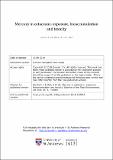Files in this item
Mercury in cetaceans : exposure, bioaccumulation and toxicity
Item metadata
| dc.contributor.author | Kershaw, Joanna | |
| dc.contributor.author | Hall, Ailsa | |
| dc.date.accessioned | 2020-07-29T23:41:30Z | |
| dc.date.available | 2020-07-29T23:41:30Z | |
| dc.date.issued | 2019-12 | |
| dc.identifier | 260343362 | |
| dc.identifier | ea24c784-ffec-4170-914f-9e4cf118a49d | |
| dc.identifier | 85070094626 | |
| dc.identifier | 000496780900006 | |
| dc.identifier.citation | Kershaw , J & Hall , A 2019 , ' Mercury in cetaceans : exposure, bioaccumulation and toxicity ' , Science of the Total Environment , vol. 694 , 133683 , pp. 1-11 . https://doi.org/10.1016/j.scitotenv.2019.133683 | en |
| dc.identifier.issn | 0048-9697 | |
| dc.identifier.uri | https://hdl.handle.net/10023/20371 | |
| dc.description | The authors would also like to thank the International Whaling Commission Scientific Committee and the Sea Mammal Research Unit National Capability Funding from the Natural Environment Research Council (NERC, grant no. SMRU 10001) who funded this work. | en |
| dc.description.abstract | The fate and transportation of mercury in the marine environment are driven by a combination of anthropogenic atmospheric and aquatic sources, as well as natural geological inputs. Mercury biomagnifies up the food chain, resulting in the bioaccumulation of toxic concentrations in higher trophic organisms even when concentrations in their habitat remain below the threshold level for direct toxicity. As a result, mercury exposure has been recognised as a health concern for both humans and top marine predators, including cetaceans. There appears to be no overall trend in the global measured concentrations reported in cetaceans between 1975 and 2010, although differences between areas show that the highest concentrations in recent decades have been measured in the tissues of Mediterranean odontocetes. There is increasing concern for the impacts of mercury on the Arctic marine ecosystem with changes in water temperatures, ocean currents, and prey availability, all predicted to affect exposure. The accumulation of mercury in various tissues has been linked to renal and hepatic damage as well as reported neurotoxic, genotoxic, and immunotoxic effects. These effects have been documented through studies on stranded and by-caught cetaceans as well as in vitro cell culture experiments. Demethylation of methylmercury and protection by selenium have been suggested as possible mercury detoxification mechanisms in cetaceans that may explain the very high concentrations measured in tissues of some species with no apparent acute toxicity. Thus, the ratio of selenium to mercury is of importance when aiming to determine the impact of the contaminant load at an individual level. The long-term population level effects of mercury exposure are unknown, and continued monitoring of odontocete populations in particular is advised in order to predict the consequences of mercury uptake on marine food chains in the future. | |
| dc.format.extent | 11 | |
| dc.format.extent | 1124480 | |
| dc.language.iso | eng | |
| dc.relation.ispartof | Science of the Total Environment | en |
| dc.subject | Detoxification | en |
| dc.subject | Health | en |
| dc.subject | Marine mammals | en |
| dc.subject | Methylmercury | en |
| dc.subject | Toxicity | en |
| dc.subject | GC Oceanography | en |
| dc.subject | QH301 Biology | en |
| dc.subject | 3rd-DAS | en |
| dc.subject | SDG 14 - Life Below Water | en |
| dc.subject.lcc | GC | en |
| dc.subject.lcc | QH301 | en |
| dc.title | Mercury in cetaceans : exposure, bioaccumulation and toxicity | en |
| dc.type | Journal item | en |
| dc.contributor.institution | University of St Andrews. School of Biology | en |
| dc.contributor.institution | University of St Andrews. Sea Mammal Research Unit | en |
| dc.contributor.institution | University of St Andrews. Marine Alliance for Science & Technology Scotland | en |
| dc.contributor.institution | University of St Andrews. Scottish Oceans Institute | en |
| dc.identifier.doi | 10.1016/j.scitotenv.2019.133683 | |
| dc.description.status | Peer reviewed | en |
| dc.date.embargoedUntil | 2020-07-30 |
This item appears in the following Collection(s)
Items in the St Andrews Research Repository are protected by copyright, with all rights reserved, unless otherwise indicated.

